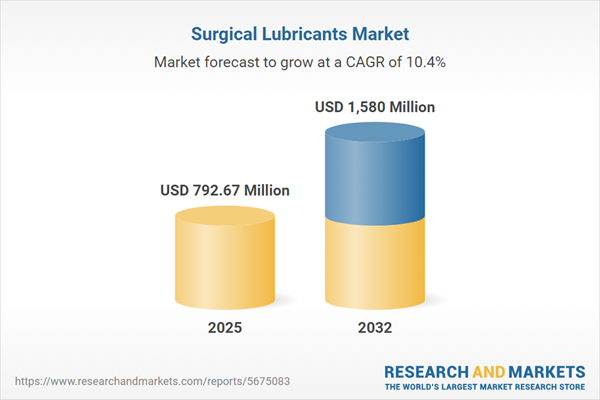Speak directly to the analyst to clarify any post sales queries you may have.
The global surgical lubricants market supports secure, standardized patient care by delivering dependable solutions for procurement and compliance teams. This analysis helps senior decision-makers optimize purchasing, manage risks, and enhance operational flows within regulated healthcare systems.
Market Snapshot: Global Surgical Lubricants Market
The surgical lubricants market continues to display steady growth, reaching a value of USD 717.60 million in 2024 and forecasted to grow to USD 792.67 million by 2025. By 2032, the market is expected to surpass USD 1.58 billion, with a compound annual growth rate (CAGR) of 10.43%. Increased demand for minimally invasive surgeries, a strong focus on patient safety, and advancements in digital integration within surgical settings are shaping the industry. Strategic investments in healthcare infrastructure and effective adaptation to varying global regulations are supporting the market’s resilience. Additionally, manufacturers’ innovation in delivery mechanisms enhances adoption and sustains relevance across all major regions.
Surgical Lubricants Market: Scope & Segmentation
- Lubricant Types: Oil-based lubricants deliver lasting performance for intensive procedures, while water-based options are valued for broad equipment compatibility. Silicone-based formulations—including gels and sprays—are tailored for high-precision interventions.
- Application Areas: Surgical lubricants are integral in diagnostic interventions such as bronchoscopy, colonoscopy, and gastroscopy, as well as routine and specialized operations, supporting procedural safety and clinical consistency.
- End User Profile: Hospitals, ambulatory surgical centers, and clinics each present unique workflow and supply requirements, directly influencing lubricant specification and procurement strategies.
- Distribution Channels: Hospital pharmacies, retail stores, and online procurement networks create flexible access to surgical lubricants, allowing healthcare organizations to react quickly to shifting inventory needs.
- Geographical Reach: The Americas, Europe, Asia-Pacific, Middle East, and Africa feature highly variable healthcare structures and regulations, shaping technological uptake and localized procurement approaches.
- Company Landscape: Major industry participants such as Johnson & Johnson, McKesson Corporation, Cardinal Health, Medline Industries, ConvaTec Group, B. Braun Melsungen, Mölnlycke Health Care, Paul Hartmann, Sarstedt AG, and Kimberly-Clark play ongoing roles in product development, compliance, and sector-wide innovation.
Surgical Lubricants Market: Key Takeaways for Senior Decision-Makers
- Modern surgical environments benefit from the integration of advanced medical technologies, which streamline workflows and encourage consistent clinical performance.
- Leading suppliers are placing greater emphasis on traceability and compliance, aligning lubricant sourcing and usage with regional sterilization and quality standards.
- There is an increasing shift toward environmentally conscious procurement, led by the adoption of water-based and plant-derived lubricant formulations that fit institutional sustainability targets.
- Digital inventory management and real-time tracking tools are being implemented to improve procurement agility and optimize resource distribution, particularly in extensive hospital networks.
- Supply chain strategies now incorporate flexible sourcing via direct and online channels, supporting responsiveness to changing demand and minimizing potential disruptions.
- Buyers are responding to regulatory-driven frameworks by tailoring procurement approaches to account for technological readiness and local compliance needs, strengthening organizational future readiness.
Tariff Impact: Supply Chains and Cost Structures
Recent changes in U.S. tariff policy are influencing the total cost and reliability of surgical lubricant supplies. Healthcare organizations mitigate these impacts through nearshoring activities, blending traditional and digital sourcing methods, and engaging proactively with regulatory requirements. This multi-pronged approach stabilizes inventories and helps maintain continuity across volatile market conditions.
Methodology & Data Sources
This market analysis synthesizes insights from healthcare executives, clinical practitioners, and supply chain specialists. Data are drawn from regulatory filings, peer-reviewed industry literature, and recognized market reports, ensuring procurement and executive teams access credible, actionable information.
Why This Report Matters
- Facilitates risk control by equipping leadership with timely, targeted data to anticipate and adapt to changes in regulation or procurement landscapes.
- Drives more informed supplier and product assessments, leading to operational improvements and enhanced decision-making for clinical and purchasing leaders.
- Empowers organizations to proactively manage evolving regulatory demands and sustainability priorities, leveraging insights tailored to real-world healthcare settings.
Conclusion
Effective selection and management of surgical lubricants underpin procedural safety and reliable patient outcomes. This report delivers the foundation for strategic procurement improvements and operational alignment for healthcare leaders.
Additional Product Information:
- Purchase of this report includes 1 year online access with quarterly updates.
- This report can be updated on request. Please contact our Customer Experience team using the Ask a Question widget on our website.
Table of Contents
3. Executive Summary
4. Market Overview
7. Cumulative Impact of Artificial Intelligence 2025
Companies Mentioned
The companies profiled in this Surgical Lubricants market report include:- Johnson & Johnson
- McKesson Corporation
- Cardinal Health, Inc.
- Medline Industries, L.P.
- ConvaTec Group PLC
- B. Braun Melsungen AG
- Mölnlycke Health Care AB
- Paul Hartmann AG
- Sarstedt AG & Co. KG
- Kimberly-Clark Corporation
Table Information
| Report Attribute | Details |
|---|---|
| No. of Pages | 185 |
| Published | October 2025 |
| Forecast Period | 2025 - 2032 |
| Estimated Market Value ( USD | $ 792.67 Million |
| Forecasted Market Value ( USD | $ 1580 Million |
| Compound Annual Growth Rate | 10.4% |
| Regions Covered | Global |
| No. of Companies Mentioned | 11 |









